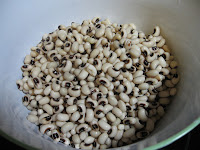 |
| You can tell it's Southern cooking by the parrot! |
My first attempt at sweet potato casserole falls in the "less successful" category. It was tasty, but it wasn't what my expert taste-tester expected and it needs some work.
But I'm not proud - I'm happy to share the tasty failures, too!
 |
| Mis en place for sweet potato casserole The bowl at left is cornmeal for fried cornbread |
You know how it is when you watch one of those shows, and they have little dishes of every ingredient already measured and ready in a tiny glass bowl? They never waste camera time measuring, and it's also a great way to determine that you have every ingredient.
 In fact as I was setting up for this recipe I discovered that I didn't have miniature marshmallows. Fortunately the grocery store is only three blocks away. On a cooking show there would be an able assistant, ready to run do the chef's bidding at any moment. For me that was the amazing husband/photographer/Official Taster, who ran to the store for marshmallows as I started cooking.
In fact as I was setting up for this recipe I discovered that I didn't have miniature marshmallows. Fortunately the grocery store is only three blocks away. On a cooking show there would be an able assistant, ready to run do the chef's bidding at any moment. For me that was the amazing husband/photographer/Official Taster, who ran to the store for marshmallows as I started cooking.Because the Official Taster prefers yams, that is what I actually used. Most any variety of sweet potato or yam will work, but that may be part of what went wrong with mine. I will need to experiment with either different tubers. But once they were peeled and chopped I put them on to boil until tender.
While the yams simmered, I took a few minutes to clean up the kitchen. I have discovered that this kind of cooking - with new recipes and sometimes unfamiliar ingredients - can create a lot of havoc in my kitchen, and lead to many piles of dirty dishes. Since I have an older house, built at the end of WWII, it doesn't have a dishwasher. Someday, I have promised myself, we will remodel the kitchen. Someday!
 |
| Bubble, bubble Sweet potato trouble! |
After a few minutes at a slow boil, the yams were fork-tender and ready to mash. The recipe called for three cups of mashed sweet potato, which seemed like a lot for two people, so I used two small yams and cut the rest of the ingredients in half. It was plenty, and we even had leftovers.
Once the yams were tender, I drained them in a colander and returned them to the pan to mash them. I have an ancient hand masher, which was all I needed to smash the yams without completely destroying the texture.
 |
| An old-fashioned hand masher works just fine! |
However, I think I may have over cooked the yams. The consistency, as you will soon see, was thinner than I would have liked. The Official Taster also said it should have been more like dense mashed potatoes than the dish I produced. Thus the label of Tasty Failure.
But I digress...
 |
| Sugar |
Once the yams were mashed, I added the remaining ingredients,
Sugar ...
 |
| Butter |
Butter ...
Milk ...
Eggs and vanilla,
and poured the resulting mash into a baking pan.
 |
| Tasty, but way too soupy! |
This is when we realized the mixture wasn't as thick as we thought it should be. There wasn't a lot I could do at this point, so I forged ahead with the topping
 |
| A chef's trick, right in my own kitchen |
 |
 I mixed the nuts, brown sugar and flour into the melted butter, and then added the miniature marshmallows.
I mixed the nuts, brown sugar and flour into the melted butter, and then added the miniature marshmallows. I spread the topping over the mashed yams in the baking dish, and it was ready for the oven.
After baking, the casserole was a beautiful, bubbly brown on top, with puffs of golden melted marshmallows. It smelled great, and tasted fine, but it wasn't exactly ready for its close-up. Here's hoping I can do a better job next time, and show you a finished product that will make your mouth water!
But for the record, here is a plate of the finished casserole. Too soft to hold its shape, it probably belongs in a small bowl rather than on a plate - it was more like a pudding than a casserole, and it's quite sweet, too.
Stay tuned for more Southern cooking adventures soon!! Maybe I'll get the pictures for that banana pudding ...
Sweet Potato Casserole
3 cups boiled and mashed sweet potatoes
1 cup sugar
1/2 cup milk
1/3 cup butter
1 tsp vanilla
2 eggs, lightly beaten
Add sugar, milk, butter, eggs, and vanilla to mashed sweet potatoes. Place in an oven-proof casserole and top with a mixture of
1/3 cup melted butter
1/3 cup all-purpose flour
1 cup brown sugar
1 cup chopped nuts, pecans preferred, but walnuts also work
1 cup coconut (optional, according to the Official Taster)
1 cup miniature marshmallows
Bake at 350 degrees until brown and bubbly, about 30 minutes



































